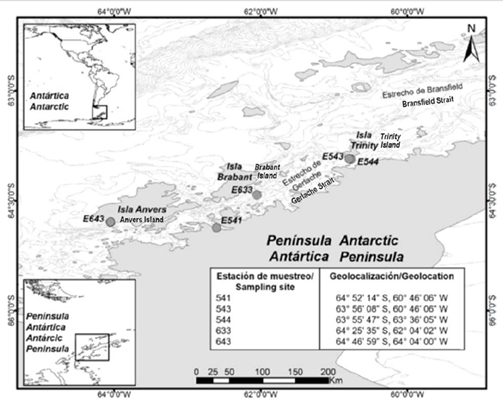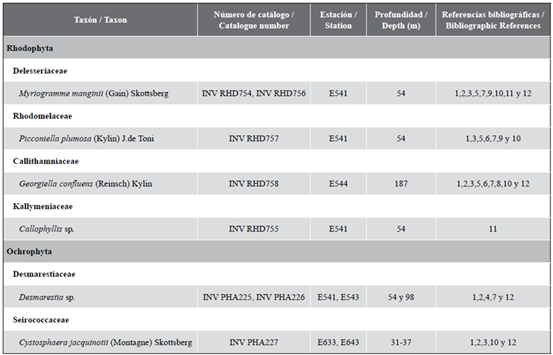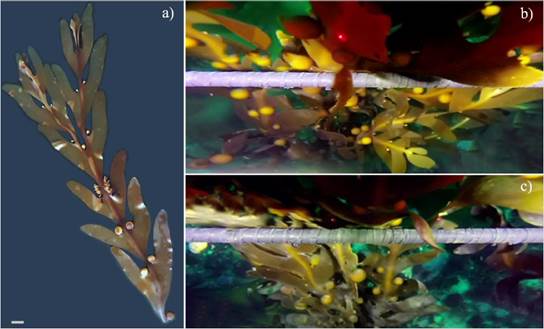The Invemar (Marine and Coastal Research Institute) has participated in scientific expeditions to the Antarctic continent since 2014. We started with the “Caldas Expedition” (2014-2015), later we participated in the “Admiral Padilla Expedition” (2016-2017), and the last southern summer 2018-2019, were part of the “Admiral Campos Expedition” with the project: Biodiversity and Oceanographic Conditions of the Strait of Gerlache “Biogerlache-Antarctica”. The aim has been to characterize the Antarctic fauna and flora of the Gerlache Strait, to create a baseline of biological knowledge that generates new contributions to the Antarctic inventories as a basis for the establishment of possible conservation areas, and to define management and protection strategies, for these ecosystems.
Among the benthic groups monitored are macroalgae, organisms at the base of the food chain of marine ecosystems. Seaweed also provides spawning and refuge areas for various species and contributes significantly to global biogeochemistry (Mystikou et al., 2014). In rocky temperate, and polar coastal environments, the brown algae are the principal primary producers, and together with red algae dominate in composition and abundance (Mystikou et al., 2014).
The macroalgae were collected in expeditions carried out in the years 2016-2017 and 2018-2019, in sites with depths from 35 to 187 m; close to Trinity Island, Palmer Station, Andvord Bay and Mikkelsen Harbor (Figure 1). Seaweeds were collected using a Shipek type dredge that detached them from the rocky substrate. Underwater videos were recorded of environments dominated by brown algae Cystosphaera jacquinotii with a ROV FO III Mariscope (Remote Operated Vehicle) at E643 station, between depths of 31-37 m (Figure 2b, c). Also, a specimen found drifting at E633 station, near Brabant Island, was collected.

Figure 1 Spatial position and geolocation of the stations where the macroalgae were collected in the Gerlache Strait, Antarctica. Source: Labsis, Invemar.
Macroalgae were identified in the laboratory using taxonomic keys and specific references for Antarctica (e.g.Ricker, 1987; Chung et al., 1994; Yoneshigue-Valentin et al., 2012; Mystikou et al., 2014; Wiencke et al., 2014; Gómez et al., 2015). The samples were preserved in 96 % ethanol, some pressed and dried, and entered the collections of the Museo de Historia Natural Marina de Colombia (MHNMC)-Makuriwa. The nomenclature, scientific names, and authorities were assigned according to Guiry and Guiry (2020).
Eight macroalgae samples were collected. We identify four species of red algae (Rhodophyta) belonging to two orders and three families and two brown algae (Ochrophyta-Phaeophyceae), grouped in two orders and two families (Table 1). According to Callophyllis sp., and Desmaresta sp., the collected specimens were incomplete or damaged; this made it impossible to get all the diagnostic characters to define the species.
This study is the first report made by Colombian research on the knowledge of the macroalgae of Antarctica, their biodiversity, and their distribution. Although the species found in the expeditions correspond to records previously documented for the continent (Table 1), the findings broaden the information on the depth ranges.
From red algae, Myriogramme manginii was identified. This species, found at 54 m depth, has been reported in intertidal areas, from 1 to 5 m by De laca and Lipps (1976) and at 11 m depth by Richardson (1979). However, it has also been found in a wide depth range, from 10 to 57 m (Zielinski, 1990), the maximum depth similar to reported in this work. Regarding Picconiella plumosa, collected at 54 m deep, it is abundant at depths greater than 20 m and has been reported between 8 to 35 m in the same area (Wiencke, 2011) and up to 60 m growing in aggregations with other species (Zielinski, 1990). During the dredging carried out at station E544, a specimen of Georgiella confluens was collect at 187 m. This red alga had been previously reported by Klöser et al. (1996) in the vertical faces of the rocky promontories of Antarctica up to 25 m depth, while Zielinski (1990) found it in the subtidal from 5 to 60 m and Delépine (1966) in the lower infralittoral, at more 30 m. Callophyllis sp., is poorly documented in terms of depth for the area. However, it was reported in samplings made up to 33 m depth by Moe and DeLaca (1976). In this work, it was found growing in aggregations with P. plumosa, M. manginii, and the brown alga Desmarestia sp., at 54 m. This being an important depth record for the genus in the region.
Table 1 List of macroalgae species collected within the framework of the project “Biodiversity and Oceanographic Conditions of the Gerlache Strait” Biogerlache-Antarctica” includes bibliographic references for the area and information on the collection stations.

1. Papenfuss (1964), 2. Westermeier et al. (1992), 3. Chung et al. (1994), 4. Peters et al. (2000), 5. Peters et al. (2005), 6. Quartino et al. (2005), 7. Amsler et al. (2005), 8. Hommersand et al. (2006), 9. Hommersand et al. (2009), 10. Yoneshigue-Valentin et al. (2012), 11. Mystikou et al. (2014), 12. Wiencke et al. (2014).
The endemic algae species of Antarctica are strongly represented by large brown algae (Gómez et al., 2015). These form an important component of the flora dominating in abundance and biomass (Lee, 2008). Among the representative genera is Desmarestia sp., which is particularly distributed between 5 and 30 m depth along the vertical zonation of the littoral environment (Quartino et al., 2020). Desmarestia anceps has been found coexisting with Myriogramme manginii, low-growing algae that bear delicate fronds (Amsler et al., 1995), a situation that was also observed in the sampling carried out at a depth of 54 m with the algae Desmatestia sp. (Table 1).
Under deep subtidal environments, the number of species increases significantly, forming specific belts of broad coverage and biomass (Knox, 1960; Hedgpeth, 1971; Lamb and Zirnmerman, 1977; Etcheverry, 1983). At greater depths where the impact of ice decreases, it is common to find C. jacquinotii, an endemic species from Antarctica, was collected in drift and observed covering a broad extension from 31 to 37 m deep from underwater ROV images (Figure 2b, c). Previous records for the species were documented by Neushul (1963) and Wulff et al. (2009), who found the brown algae between 5 and 30 m in exposed areas and above 66° S.

Figure 2 Cystosphaera jacquinotii. a) Specimen collected in drift in the vicinity of Brabant Island, during the 2019 Antarctic expedition, bar scale: 2 cm. b and c) Underwater ROV image at station E643, where a patch of C. jacquinotii was found between 31 and 37 m deep.
The high sensitivity to climate change has made Antarctica a region of interest since is facing an accelerated temperature increase, with unpredictable consequences for the biota (Gómez et al., 2015). The new findings in terms of depth and sampled sites provide information on the dynamics of the macroalgae species representative of Antarctica, useful in the developing assessments on the effects of global warming and various anthropic pressures in the region. This highlights the importance to continue including seaweeds as a study group in future research expeditions due to their role as biological indicators of the condition of the ecosystems in Antarctica, which will contribute to the formulation of conservation and management measures.











 text in
text in 



